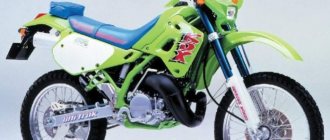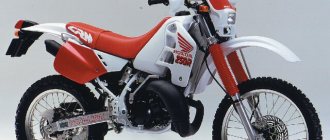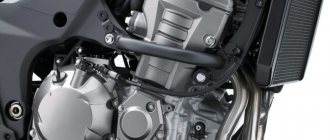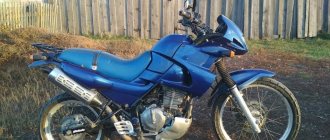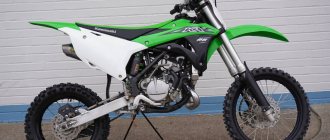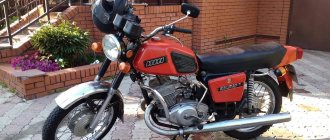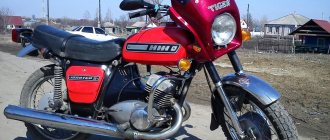The Kawasaki KLX 250 enduro motorcycle is one of the brand’s longest-running projects. The first generation of the motorcycle was released in 1979 . Over the course of forty years, the motorcycle was updated, received new solutions and modifications, was divided into separate branches , and then merged again. It received its usual appearance in 1993 .
Production continues. Versions after restyling in 2009 have all the lighting devices, mirrors, and most importantly, a PTS.
Appearance
The Kawasaki KDX 250 looks like a typical enduro. Colors vary, but the color usually appears is green. The light green bike with a blue seat and shock absorbers looks especially impressive. The front light is small and square, like enduro and supermoto.
Spoke wheels make the bike lighter. The front wheel is slightly larger than the rear. The details are clearly visible, which gives the bike a unique effect. However, the frame covers a significant part. There are many similarities between the appearance of the KDX 250 and motocross bikes.
Main generations of Kawasaki D-Tracker 250:
Kawasaki D-Tracker 250 (1998-2007) - first generation. Produces 30 hp. power, is equipped with a carburetor and has a fuel tank of 8 liters. The model was also sold under the name Suzuki SB250.
Kawasaki D-Tracker X (2008-) - second generation. Known as the KLX250SF in the North American and Australian markets. The model has a more modern appearance, an injector (KLX250SF - carburetor), brake discs of increased diameter, a 7.7 liter fuel tank and a power of 23 hp.
Comfort
The motorcycle is convenient primarily for those who like to travel to places with not very good roads or without them. A tourist or, especially, a sports-tourist option is not suitable here. And enduro copes well with mud and other difficulties of wild places.
Of course, you won’t be able to take anything with you other than a backpack. But with a competent approach to motorcycle tourism, nothing else is needed. It is important that you have at least two GPS navigators with you, and that the route is thoroughly thought out. Otherwise, the bike is convenient, including maintenance and searching for spare parts.
Competitors
In the photo on the left is the Kawasaki KLX 250, on the right is the Yamaha WR250R.
The competitors for the motorcycle are:
- Honda CRF250L.
- Yamaha WR250.
But the Suzuki 250 SB is also noted, but it is more often compared to the Kawasaki D-Tracker 250 motard, which is based on the KLX 250.
Dimensions and weight
In terms of dimensions, this bike meets class standards. Weight, ground clearance, wheelbase - all this makes the motorcycle excellently passable and controllable in wild and difficult conditions. But we can’t say that this is a special advantage of a particular model, because most other enduros have the same dimensions.
Dimensions and weight are:
- height – 1250 mm;
- width – 850 mm;
- length – 2165 mm;
- wheelbase – 1475 mm;
- seat height – 955 mm;
- ground clearance - 340 mm;
- curb weight – 116 kg;
- Tank capacity – 12.5 l.
The fuel tank capacity will last a long time, although it is small. So it is important to make sure that you come across gas stations on time along the route, because there will be no other opportunity to refuel the tank on such a trip.
Modifications and generations
Over its 40-year life, the motorcycle has gone through 5 generations and several modifications.
Interestingly, the seat height of the bike differs significantly depending on the model - 925 mm for the KLX250-D version, 890 mm for the KLX250-E, S, T and 885 mm for the KLX250-F, H.
- In 1979, production of the model began as a more powerful analogue for the Kawasaki KX125 enduro produced in parallel. First generation.
- 1993 . Dramatic change. The model moves away from 2-stroke models and gets a modern look. It is divided into two motorcycles - Kawasaki KLX250R , a classic Enduro without unnecessary parts (optics, mirrors, instrument panel |) and a vehicle title. And also the Kawasaki KLX250SR - a complete set of parts missing from the second version. The presence of a PTS allows you to travel to additional traffic areas after registration. Second generation
- 1994 . Another restyling, and another division. Kawasaki KLX250 - version with documents for European countries. Kawasaki KLX250ES - Japanese version. Kick starter missing. Third generation.
- 1997 . Production of all early modifications is closed. The model is called Kawasaki KLX250, has all the documents. A more powerful headlight was installed, and the engine was slightly reconfigured to comply with EURO-3. Fourth generation.
- 2008 . The fifth generation marks the bike's transition to fuel injection. Other changes are not significant. Europe version
- year 2009 . Sixth generation. Restyling of American versions. Outwardly, they become similar to the Europeans launched a year earlier, Return to the carburetor, Carpet, the model name is Kawasaki KLX250S, as evidenced by the nameplates on the plastic.
Specifications
According to these parameters, the bike is not inferior to many others, although it is not advanced. It is important to remember the time when it was produced and make allowances when comparing with current enduro representatives. However, even today, in terms of technical characteristics, the car remains competitive with weak current models.
| Motor type | in-line, 1 cylinder, 2 stroke |
| Power | 40 hp |
| Torque | 40.2 Nm |
| Maximum speed | 180 km/h |
| Acceleration to 100 | 7.1 s |
| Fuel consumption per hundred | 7 l |
| Drive unit | chain |
| Transmission | five-speed |
| Frame | half-duplex steel |
| Rear suspension | pendulum, monoshock absorber, stroke 310 mm |
| Front suspension | inverted fork, 300 mm travel |
| Rear brakes | 1 disc, 190 mm, 1-piston caliper |
| Front brakes | 1 disc, 220 mm, 2-piston caliper |
Such parameters make this bike suitable for those who want to try off-road riding, but are wary of some powerful motocross bike. Also, connoisseurs of old representatives of the class will appreciate how the car is made and the path it has traveled.
Peculiarities
The rear suspension is an adjustable pendulum Uni-Trak with a monoshock absorber.
The features of the model include:
- Complete absence of vibrations . Despite the fact that there is only 1 cylinder, there are no problems at normal enduro speeds. If you rev the engine to the red zone, they may appear, but only slightly.
- Electronic instrument panel. Installed only on versions for Europe starting from the fifth generation. Tachometer, speedometer, two trip meters, gear indicator. Additionally, a clock and a fuel indicator. In addition, a standard set of light bulbs: high beam, neutral, turn signals.
Instrument panel - 1999 release.
Instrument panel - 2014 release.
- Standard mirrors . Small size, absolutely flat. Even though it is round, it does not provide a “picture without blind spots”. It is recommended to change immediately.
- Checkpoint . Having a sore characteristic of the brand ( fuzziness ), it is configured in such a way that for most cases one gear is enough. At least for starting off, at least for wheelie.
Since 2004, motorcycle assembly in Japan has been closed. All models of subsequent years come to the market from Thailand.
There are also good opportunities for shooting between rows , the opportunity to upset road inspectors with the presence of registration and rights, and much more.
History of changes
There have been few changes, but this is good, because it speaks about the quality of the bike. This means that the equipment was originally designed in such a way that almost nothing had to be modified. Those changes that have been made are more likely to be cosmetic. However, these are also important to note.
Here's the evolution of the Kawasaki KDX 250:
- In 1981 there was a restyling. Since then, the model is already considered the second generation.
- In 1991, the third generation saw the light. There was a new restyling, and a couple of modifications arose.
- In 1995, the last year of production, all modifications were no longer offered.
The fact that production stopped is natural given the development of technology. Updating an enduro, sport bike or even road motorcycles to a modern, up-to-date state is not easy, because it is much cheaper and more expedient to release a new motorcycle from scratch that keeps up with modern times.
What do the owners say?
The motorcycle is reliable, which is clear from the photos and videos. Most owners agree with this. However, someone notes that among all the enduros he has tried, this is not the most reliable.
According to the descriptions of those who have been traveling this way for a long time, the bike usually does not fail, but they still do not advise traveling far from civilization.
Judging by the reviews, it is possible to get good used equipment, but it is important to carefully read the documents. It is advisable to apply all modern methods of checking the condition of the bike to make sure that the machine is well preserved. If the equipment looks good on the outside, this does not mean anything.
Also, one review or another notes that this motorcycle is easy to buy. About 100 thousand Russian rubles – that’s how much such a model costs. The car is praised for its handling and ease of use, but few people called this option the best in the enduro class.
In conclusion, the Kawasaki KDX 250 is the choice for those who want to travel alone and without luggage. The bike is reliable and comfortable, although the best results at the end of the twentieth century were, of course, achieved by Honda. In any case, the machine from Kawasaki is not bad and is still capable of competing with current models.
General reviews
According to the owners of the Kawasaki KLX 250, this enduro bike is the ideal “road” motorcycle for the Russian Federation.
The Kawasaki KLX 250 model is not a cross-country bike, not a street moto and not an enduro in its pure form, but a symbiosis of one, two and three.
Among its advantages are noted:
- Possibility to register and drive according to additional traffic regulations legally (don’t forget about category “A” licenses).
- go down the steps.
- jump onto a high curb.
- fly through a traffic jam at a speed of 50 km/h .
- rock a wheelie or stoppie even at 40 km/h .
- easily fly over potholes about 70 cm .
- crawl through the narrowest cracks in traffic.
At the same time, this motorcycle cannot be classified as for beginners either . A rather sharp pick-up almost from the very bottom, dynamics and lightness, can create a pre-emergency situation.
The Kawasaki KLX 250 will be an ideal choice for those who do not like to waste time in traffic jams, and often drive off the asphalt for duty or for pleasure.
